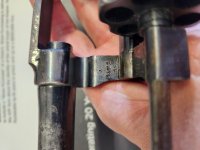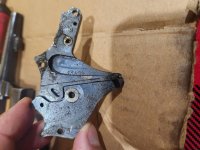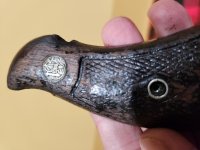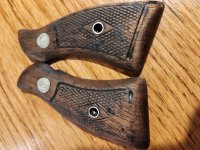Thank you everyone for your input. It is exactly what I needed. I thought i had a 10-5 because there was a -5 behind the yoke. I found out I have a M&P 4 screw made in 1956. As for restoration cleaned the bore out, completely taken apart for ballistol bath and brass brush scrub. I'll blue the gun using Blue Wonder and will try to strip these grips since they are the originals. Thanks again!
You are using an out of date browser. It may not display this or other websites correctly.
You should upgrade or use an alternative browser.
You should upgrade or use an alternative browser.
Help verifying my Model 10-5 and tips on restoration.
- Thread starter Cubs249
- Start date
I'm just wondering now, but the OP shows the gun with the side plate off and the sliding hammer block not there, so was it in there when the plate came off?
Yes, I have it.
Attachments
I think this is the perfect plan of action for this revolver. It will look better and you can shoot it till you run out money for ammo.Thank you everyone for your input. It is exactly what I needed. I thought i had a 10-5 because there was a -5 behind the yoke. I found out I have a M&P 4 screw made in 1956. As for restoration cleaned the bore out, completely taken apart for ballistol bath and brass brush scrub. I'll blue the gun using Blue Wonder and will try to strip these grips since they are the originals. Thanks again!
Thank you everyone for your input. It is exactly what I needed. I thought i had a 10-5 because there was a -5 behind the yoke. I found out I have a M&P 4 screw made in 1956. As for restoration cleaned the bore out, completely taken apart for ballistol bath and brass brush scrub. I'll blue the gun using Blue Wonder and will try to strip these grips since they are the originals. Thanks again!
I agree you need to hold onto the original grips, but they are pretty bad IMO. I do not think they will ever look presentable again. If I might suggest bagging them and keeping them with the revolver for history's sake, and getting some nicer looking used grips to mount on the revolver. Just a suggestion, your plan is good to go.
- Joined
- Aug 21, 2005
- Messages
- 8,020
- Reaction score
- 7,101
Thank you everyone for your input. It is exactly what I needed. I thought i had a 10-5 because there was a -5 behind the yoke. I found out I have a M&P 4 screw made in 1956. As for restoration cleaned the bore out, completely taken apart for ballistol bath and brass brush scrub. I'll blue the gun using Blue Wonder and will try to strip these grips since they are the originals. Thanks again!
Do not forget to re-install the hammer block. It is an essential safety feature of the revolver. It is not drop-safe without it as the US Navy found out causing S&W to re-design the hammer block during WWII. It is possible your hammer block remained in the sideplate due to oil being gummed up, etc., causing it to stay in its slot in the sideplate, but it is equally likely that some amateur kitchen-table gunsmith removed it. I saw one clown on You Tube who disassembled his Model 329, and he said he always removes it because it "rattles." If the hammer block is actually missing, it is imperative that you obtain a replacement before using that gun.
Hello I'm brand new to the forum but have already learned a bit from other people's posts. I would like to verify that I have a Model 10-5 4-screw revolver. I'd love to know when it was made and am looking for pointers on how to do an arm's length restoration on my revolver. I rescued it from a local pawn shop looking terrible with rust, pitting, and damaged grips.
Model number: 10-5
Serial Number: C 359xxx
Finish: Blued
Caliber: .38 Special
Barrel Length: 4"
Screw Count: 4
Strain Screw: Yes
You've had a lot of great advice and information here, so I thought i would give you some dumb advice.
Here's a snippet from the GunRelics website of the 1957 catalog featuring your model. I would love to run a bore scope down the barrel but I bet it is clean. To me this looks like a service pistol, police or guard. It spent a lot of time in and out of a holster and probably not a lot of time shooting.
Leather holsters are an awful place to keep a gun for 50 years, especially when it's attached to a belt and is being jostled around with each footstep, exposed to dirt and rain and sweat, then hung on the back of a chair for the evening. Slowly they will abrade, rust and degrade a pistol and it will look like this. The wear on your Magna grips look like holster wear to me along with some nice Kiwi polish. Why they put wood grips on duty pistols is beyond me.
So I am thinking I am going to pick up a good, but cheap and common gun like this. I am going to take it apart and clean it, remove rust and pits and make sure the gun is 100% functional. Then I am going to learn how to polish and finish each piece, blue it and restore it to the best of my ability. I'm just going to do it for the hell of it because I love old guns. I will try to make it look like new.
And I'm going to document it each step of the way right here.
Attachments
Last edited:
Good plan.Going to let them be and buy some grips correct to 1956.
In case you are not too familiar with the changes in S&W stocks over the years, here is what you are looking for (use those you have as a model):
1. The "soft" tapered shoulder
2. The diamond at the screw location
3. The rounded bottom edges (not squared off at the butt) - these are called "Modified Magna" stocks, AKA PC (for "Plain Clothes") Magna stocks. The PC stocks were used on the fixed sight revolvers, beginning in the early 1950s. They differed from the Magna stocks used on target sight revolvers, which had the squared butt edges.
Gun Relics: "So I am thinking I am going to pick up a good, but cheap and common gun like this. I am going to take it apart and clean it, remove rust and pits and make sure the gun is 100% functional. Then I am going to learn how to polish and finish each piece, blue it and restore it to the best of my ability. I'm just going to do it for the hell of it because I love old guns. I will try to make it look like new."
I've done some garage gunsmithing a couple of times just for fun, and had OK results. The first was with a Marlin 1895 .45-70 rifle that had been in a minor fire. Picked it up cheap at a local gun show. Tore it down, fabbed and hardened a couple of missing parts, polished, and cold blued it. I would never shoot it, and ended up turning it in at a local Sheriff's Dept. "Kicks for Guns" event for a gift card! Another was a Colt 1862 Pocket Police .36 Cal. that was a block of rust. Got it at a local auction in an old toolbox full of rusty tools. Was able to soak it and get it apart and make a few repairs. I lightly polished it and only partially cold blued the frame and barrel (except the brass) so that it still looked old. I was able to get it mostly functional, and I still have the Colt in the safe. Both projects were a lot of fun and interesting. Good luck with your future project.
I've done some garage gunsmithing a couple of times just for fun, and had OK results. The first was with a Marlin 1895 .45-70 rifle that had been in a minor fire. Picked it up cheap at a local gun show. Tore it down, fabbed and hardened a couple of missing parts, polished, and cold blued it. I would never shoot it, and ended up turning it in at a local Sheriff's Dept. "Kicks for Guns" event for a gift card! Another was a Colt 1862 Pocket Police .36 Cal. that was a block of rust. Got it at a local auction in an old toolbox full of rusty tools. Was able to soak it and get it apart and make a few repairs. I lightly polished it and only partially cold blued the frame and barrel (except the brass) so that it still looked old. I was able to get it mostly functional, and I still have the Colt in the safe. Both projects were a lot of fun and interesting. Good luck with your future project.
Gun Relics: "So I am thinking I am going to pick up a good, but cheap and common gun like this. I am going to take it apart and clean it, remove rust and pits and make sure the gun is 100% functional. Then I am going to learn how to polish and finish each piece, blue it and restore it to the best of my ability. I'm just going to do it for the hell of it because I love old guns. I will try to make it look like new."
I've done some garage gunsmithing a couple of times just for fun, and had OK results. The first was with a Marlin 1895 .45-70 rifle that had been in a minor fire. Picked it up cheap at a local gun show. Tore it down, fabbed and hardened a couple of missing parts, polished, and cold blued it. I would never shoot it, and ended up turning it in at a local Sheriff's Dept. "Kicks for Guns" event for a gift card! Another was a Colt 1862 Pocket Police .36 Cal. that was a block of rust. Got it at a local auction in an old toolbox full of rusty tools. Was able to soak it and get it apart and make a few repairs. I lightly polished it and only partially cold blued the frame and barrel (except the brass) so that it still looked old. I was able to get it mostly functional, and I still have the Colt in the safe. Both projects were a lot of fun and interesting. Good luck with your future project.
Hey I admire that but I'm talking about taking an average old gun and spiffing it up. Sounds like you dug those up from the grave!
Similar threads
- Replies
- 16
- Views
- 635
- Replies
- 4
- Views
- 232
- Replies
- 17
- Views
- 2K
- Replies
- 99
- Views
- 5K





